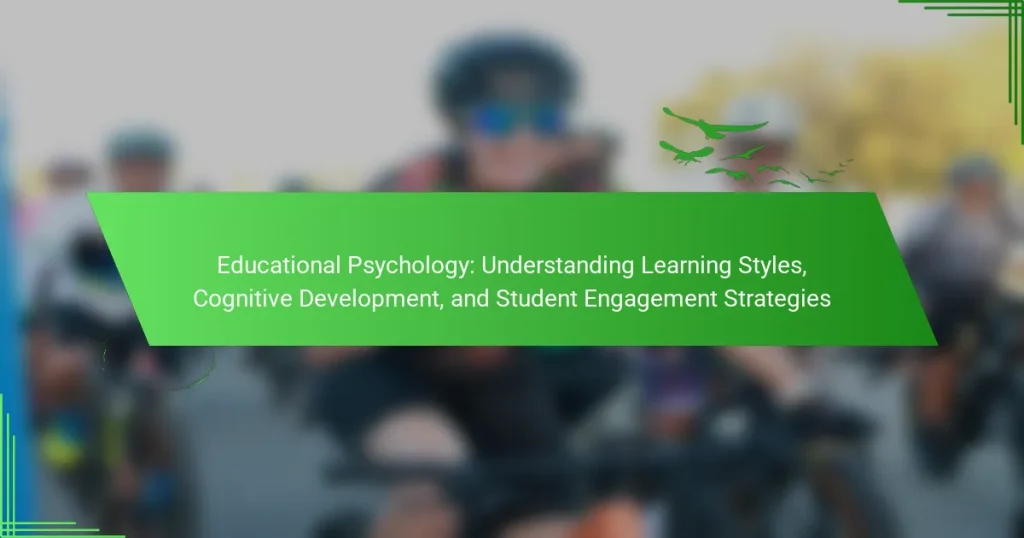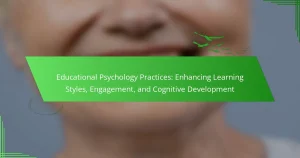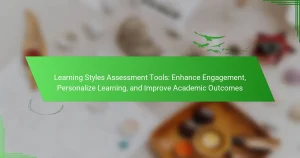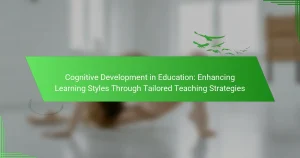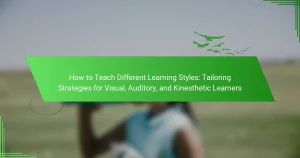Understanding learning styles and cognitive development is crucial for enhancing student engagement and academic success. This article explores personalized learning approaches, constructivist strategies, and the role of technology in education. It also examines how differentiated instruction and collaborative learning can cater to diverse learning preferences. Finally, it highlights effective methods for maximizing student motivation and participation in the classroom.
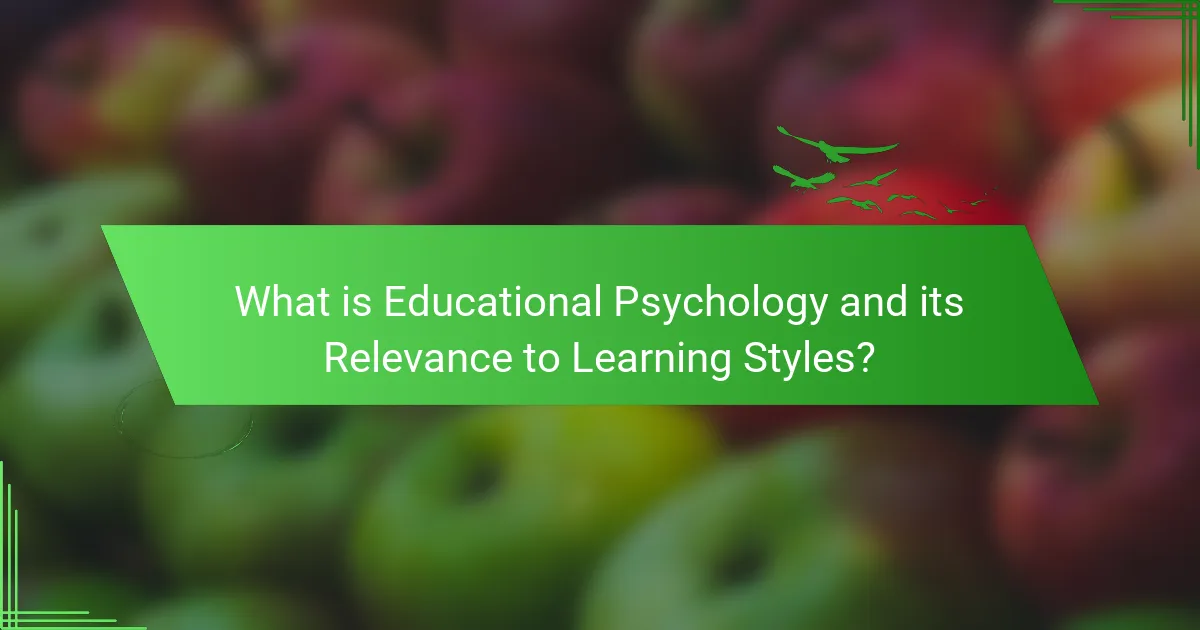
What is Educational Psychology and its Relevance to Learning Styles?
Educational psychology examines how students learn, focusing on cognitive development and engagement strategies tailored to diverse learning styles. Understanding these styles enhances teaching effectiveness and fosters student success. Research indicates that recognizing individual learning preferences can improve academic outcomes, making educational psychology essential in modern education.
How do Learning Styles Influence Cognitive Development?
Learning styles significantly influence cognitive development by shaping how students process information. Different styles, such as visual, auditory, and kinesthetic, cater to unique learning preferences, enhancing engagement and retention. Research indicates that tailoring educational strategies to these styles can improve academic performance and foster critical thinking skills. For instance, visual learners benefit from diagrams and charts, while auditory learners excel with discussions and lectures. Understanding these dynamics allows educators to design more effective teaching methods that align with individual learning needs, ultimately supporting cognitive growth.
What are the Most Common Learning Styles?
The most common learning styles include visual, auditory, and kinesthetic. Visual learners prefer images and diagrams, auditory learners benefit from listening, and kinesthetic learners learn best through hands-on experiences. Understanding these styles enhances student engagement and cognitive development.
What are the Characteristics of Visual Learners?
Visual learners typically exhibit characteristics such as a preference for visual aids, strong spatial awareness, and an inclination towards diagrams and charts. They often remember information better when it is presented visually rather than verbally. These learners benefit from the use of images, videos, and color-coded notes, which enhance their understanding and retention of concepts. Engaging with visual elements helps them process and organize information effectively.
What are the Characteristics of Auditory Learners?
Auditory learners often possess distinct characteristics that influence their learning processes. They excel in understanding spoken information and prefer listening to lectures or discussions. These learners typically retain information better when it is presented verbally, benefiting from auditory stimuli like music or sound. They may also use rhythmic patterns or mnemonic devices to aid memory retention. Additionally, auditory learners often engage in discussions to clarify concepts, valuing dialogue as a crucial learning tool.
What are the Characteristics of Kinesthetic Learners?
Kinesthetic learners are characterized by a preference for hands-on activities and physical engagement in learning. They excel in environments where they can manipulate objects, perform experiments, or participate in role-playing. These learners often benefit from movement-based activities, which enhance their retention and understanding of concepts. Common attributes include a strong sense of body awareness, preference for practical application, and difficulty with traditional lecture-based learning. Engaging kinesthetic learners effectively requires incorporating physical activities into lesson plans.
How Can Understanding Learning Styles Enhance Student Engagement?
Understanding learning styles enhances student engagement by tailoring teaching methods to individual preferences. This personalization fosters motivation and improves academic performance. Research indicates that students who learn in their preferred style show increased retention and satisfaction. For instance, visual learners benefit from diagrams, while auditory learners thrive with discussions. Adapting instructional strategies to these styles creates a more inclusive and effective learning environment.

What Unique Approaches Exist in Educational Psychology?
Unique approaches in educational psychology include personalized learning, which adapts to individual student needs, and the use of technology to enhance engagement. Additionally, constructivist strategies encourage active learning through collaboration and problem-solving. Research shows that these methods improve cognitive development and retention rates. For instance, personalized learning can increase student motivation and academic performance, reflecting a unique attribute of modern educational psychology practices.
How do VARK and Multiple Intelligences Models Differ?
VARK and Multiple Intelligences models differ primarily in their approach to learning styles. VARK categorizes learners into four types: Visual, Auditory, Reading/Writing, and Kinesthetic, focusing on sensory modalities. In contrast, the Multiple Intelligences model identifies eight distinct intelligences, including Linguistic, Logical-Mathematical, and Interpersonal, emphasizing diverse cognitive strengths. VARK offers a straightforward framework for educators to tailor instruction, while Multiple Intelligences provides a broader understanding of individual capabilities. Both models aim to enhance student engagement but do so through different lenses of cognitive development.
What Role do Emotions Play in Learning Styles?
Emotions significantly influence learning styles by affecting motivation, engagement, and retention. Positive emotions enhance cognitive development, while negative emotions can hinder learning. Research indicates that emotionally charged experiences lead to better memory retention, making emotional context crucial in educational psychology. Understanding how emotions interact with various learning styles allows educators to tailor strategies that foster a supportive learning environment, enhancing overall student engagement.
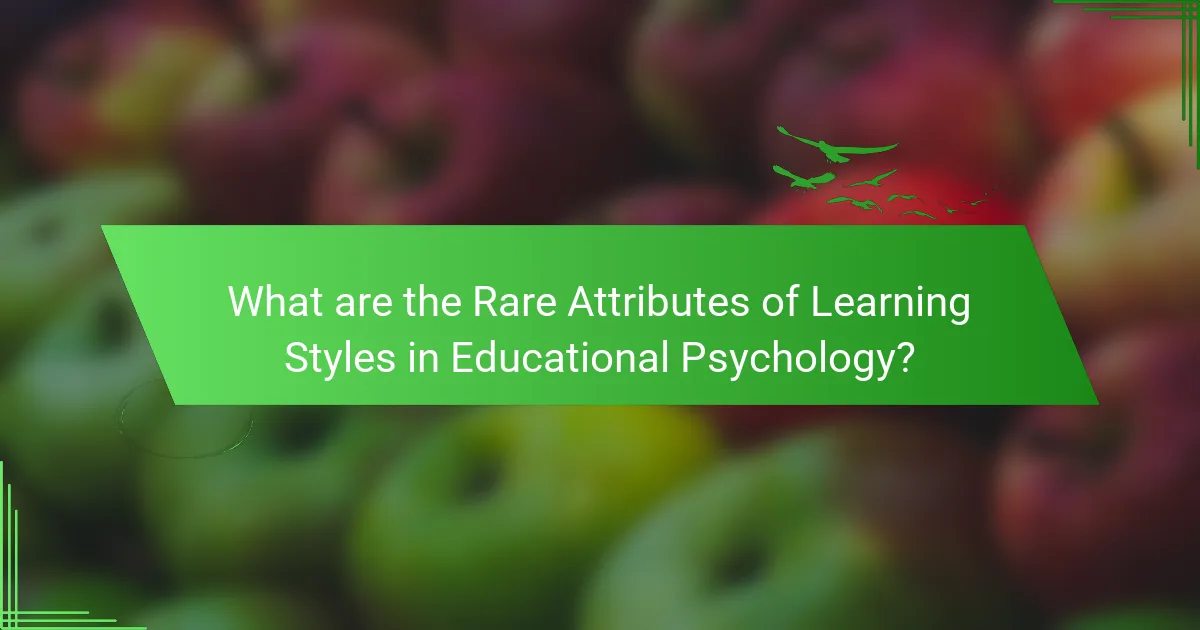
What are the Rare Attributes of Learning Styles in Educational Psychology?
The rare attributes of learning styles in educational psychology include adaptability, emotional engagement, and sensory preferences. These attributes significantly influence how students process information and interact with learning environments. Adaptability allows learners to switch between styles based on context, while emotional engagement enhances motivation. Sensory preferences highlight individual differences in how learners perceive and retain information. Understanding these rare attributes can improve educational strategies and foster better student outcomes.
How do Cultural Contexts Influence Learning Preferences?
Cultural contexts significantly influence learning preferences by shaping values, communication styles, and educational expectations. For instance, collectivist cultures often prioritize group learning, while individualistic cultures may favor independent study. This variation affects how students engage with material, collaborate, and seek feedback. Understanding these cultural differences allows educators to tailor strategies that enhance student engagement and cognitive development. Adapting teaching methods to fit cultural contexts can lead to improved learning outcomes and greater student satisfaction.
What is the Impact of Neurodiversity on Learning Styles?
Neurodiversity significantly influences learning styles by promoting diverse cognitive approaches. Students with neurodiverse conditions, such as ADHD or autism, often exhibit unique learning preferences and strengths. This diversity necessitates tailored educational strategies to enhance engagement and comprehension. For instance, visual aids may benefit students with dyslexia, while hands-on activities can support those with ADHD. Understanding these variations allows educators to implement effective, inclusive teaching methods that address the distinct needs of all learners.
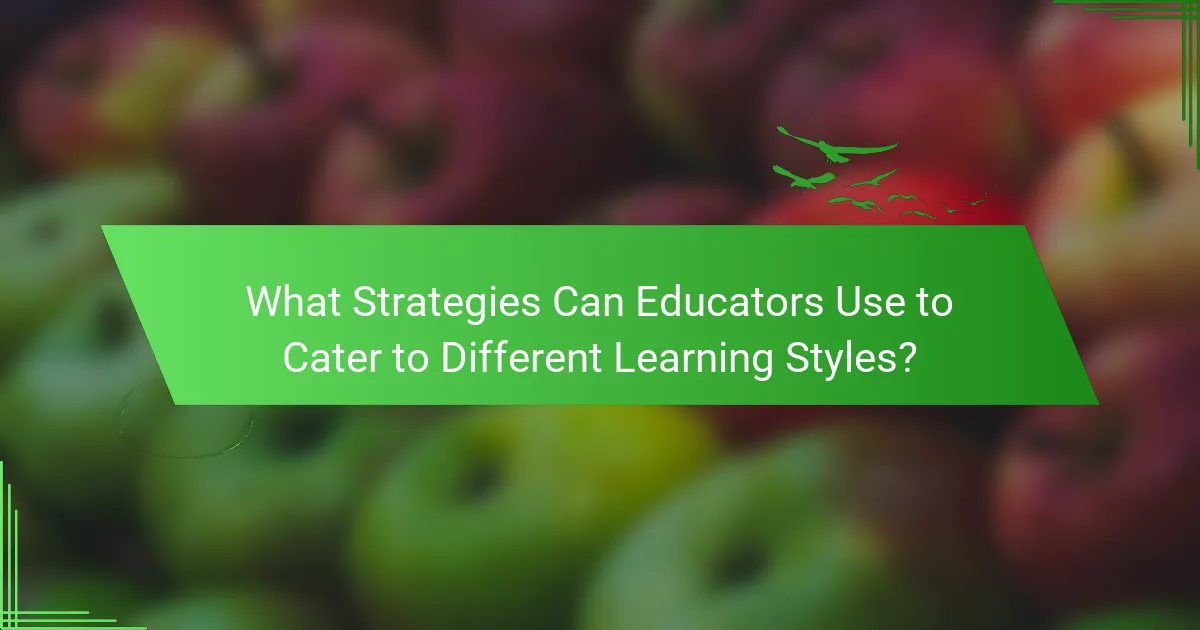
What Strategies Can Educators Use to Cater to Different Learning Styles?
Educators can use differentiated instruction, collaborative learning, and formative assessment to cater to different learning styles. Differentiated instruction tailors lessons to individual needs, allowing for varied pacing and content delivery. Collaborative learning promotes peer interaction, enhancing social and cognitive skills. Formative assessment provides ongoing feedback, helping educators adjust strategies to meet diverse learning preferences effectively.
How Can Differentiated Instruction Improve Learning Outcomes?
Differentiated instruction enhances learning outcomes by tailoring teaching methods to diverse student needs. This approach acknowledges individual learning styles, fostering engagement and improving comprehension. Research shows that students in differentiated environments demonstrate higher achievement levels. Furthermore, differentiated instruction promotes cognitive development by addressing unique attributes such as readiness, interests, and learning profiles. As a result, students become more motivated and take ownership of their learning.
What are Effective Assessment Techniques for Various Learning Styles?
Effective assessment techniques for various learning styles include diverse methods that cater to auditory, visual, and kinesthetic learners. Utilizing quizzes, group discussions, visual aids, and hands-on activities enhances engagement and comprehension. Tailoring assessments to match learning preferences improves retention and motivation. For example, offering oral presentations for auditory learners or project-based assessments for kinesthetic learners can yield better outcomes. Implementing varied assessment formats addresses unique attributes of each learning style, fostering a more inclusive educational environment.
What Common Mistakes Should Educators Avoid When Implementing Learning Styles?
Educators should avoid overgeneralizing learning styles, neglecting diverse needs, and ignoring evidence-based practices. Focusing solely on one style can limit student engagement and cognitive development. Additionally, failing to adapt teaching strategies to contextual factors diminishes effectiveness. Emphasizing flexibility in approaches enhances student learning outcomes.
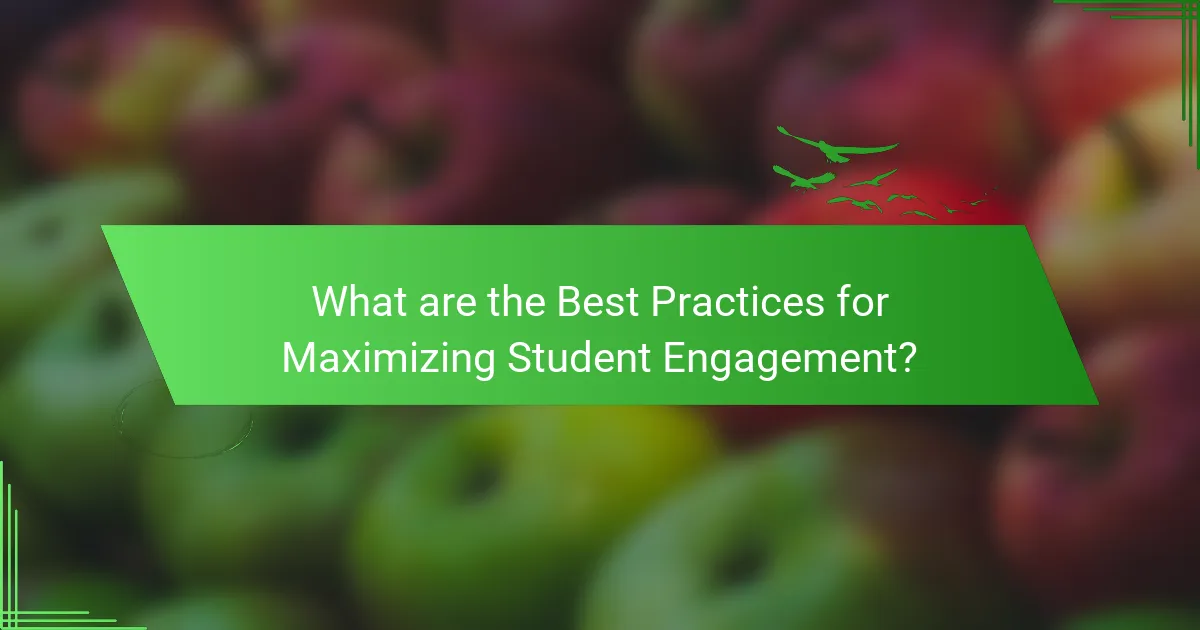
What are the Best Practices for Maximizing Student Engagement?
To maximize student engagement, educators should implement interactive teaching methods, foster a supportive classroom environment, and utilize technology effectively. Active learning strategies, such as group discussions and problem-solving activities, increase participation. Establishing strong relationships with students enhances motivation and engagement. Integrating digital tools, like educational apps and online platforms, can facilitate personalized learning experiences.
How Can Technology Support Diverse Learning Styles?
Technology can enhance diverse learning styles by providing personalized learning experiences. Adaptive learning platforms tailor content to individual needs, catering to auditory, visual, and kinesthetic learners. For instance, interactive simulations engage students who learn best through hands-on experiences. Additionally, multimedia resources support various preferences, enabling learners to absorb information in their preferred formats. The integration of gamification further motivates students, making learning enjoyable and effective. Overall, technology fosters an inclusive educational environment by accommodating different cognitive styles and promoting engagement.
What Tips Can Educators Use to Foster a Positive Learning Environment?
To foster a positive learning environment, educators should implement strategies that enhance student engagement and accommodate diverse learning styles. Creating a supportive atmosphere encourages cognitive development and participation.
Incorporating varied teaching methods caters to unique attributes of learners. For example, using visual aids benefits visual learners, while hands-on activities support kinesthetic learners. Establishing clear expectations also promotes a sense of security, allowing students to focus on learning.
Regular feedback is crucial for motivation and improvement. Providing constructive criticism helps students understand their progress and areas for growth. Additionally, fostering collaboration through group work develops social skills and enhances learning experiences.
Lastly, showing empathy and understanding towards students’ individual needs cultivates trust and respect. This unique approach contributes significantly to a positive and productive educational setting.
